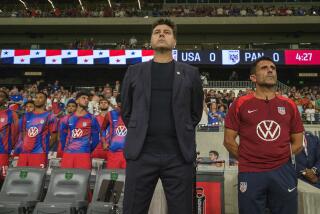A Brand-New Ball Game : WORLD-CLASS SOCCER IN THE U.S. IS A FIRST--SO IS THE MASS MULTI-LANGUAGE COVERAGE
- Share via
For a few weeks this summer, beginning Friday in Chicago’s Soldier Field and ending July 17 in Pasadena’s Rose Bowl, 24 nations representing the elite of international soccer will compete in the 15th World Cup.
Sports and TV sports coverage in the United States may never be the same.
Over the years, the United States has played host to the Olympic Games and to major championships of all kinds, but it has never staged an event quite like this.
Soccer played at the highest level is something American fans have yet to experience in person. But nine U.S. cities will discover very quickly this summer what passions soccer can arouse.
In all, 52 matches will be played, culminating in the championship game at the Rose Bowl in front of a crowd of more than 91,000 and a global television audience that could well encompass half of humankind. Soccer is, after all, the world’s most popular team sport.
The participants include the United States and defending champion Germany, as well as 22 other countries whose national teams survived up to two years of qualifying competition. A total of 141 nations started down that road; these are the elite 24 that completed the journey.
“Making Soccer History” is the slogan of the tournament and it could well come true. Already, virtually every one of the 3.5 million tickets have been sold; all 52 matches will be shown on television.
ABC Sports is broadcasting 11 of the games, including two of the U.S. first-round matches and the championship final. ESPN will televise the other 41 games, including the other U.S. first-round match, both semifinals and the third-place game. ESPN2 also will carry some games.
Twelve-time Emmy winner Jim McKay will be the in-studio anchor for ABC’s coverage, with Roger Twibell and Al Trautwig handling the play-by-play. Color commentary and analysis will be done by Rick Davis, a former U.S. national team captain, and Seamus Malin. ESPN will use a dozen commentators and analysts, including several U.S. soccer personalities.
Univision, the Spanish-language network, will broadcast all 52 matches, most of them live. Andres Cantor and Norberto Longo will be the commentators.
All matches will be shown commercial-free. Commercials will be screened only during the pre-game, halftime and post-game segments, although there will be some small commercial graphics or logos superimposed on-screen during play.
An International Broadcast Center in Dallas will coordinate broadcasts for 180 countries. The 1990 World Cup in Italy was watched by a cumulative audience of 26.7 billion. This year, that figure is expected to surpass 31 billion. By contrast, the 1992 Olympic Games in Barcelona attracted a total 16.6 billion viewers.
Germany and Brazil, both three-time World Cup champions, again are favored to win. Italy, another triple winner, will be a serious contender, as will Argentina, which has won the tournament twice before. Other nations that very possibly could reach the Rose Bowl are The Netherlands and Colombia.
But surprise is part of the World Cup excitement and 1994 could well be the year of the upset.
SOCCER TIPS FOR THE NOVICE VIEWER
If you’ve never watched a soccer game and wouldn’t recognize a player if you tripped over him, here’s an instant guide to help you understand and better enjoy what’s going on.
The thing to remember is that soccer is a simple game. The 90-minute match is divided into 45-minute halves with no timeouts. There are 11 players on each team and every one of them, in theory, is free to wander anywhere on the field he wants to. Each team is limited to three substitutions. Once a player is taken off, he cannot return. Use of hands is forbidden, except by the goalkeepers inside their own areas. The referee is in sole charge of the game. The winner is the team that puts the ball in the net most often.
There, wasn’t that simple?
Here, now, is a little more detailed explanation of the four basic player positions and their role, along with some of the stars to watch for during the World Cup.
GOALKEEPERS
They are the last line of defense, the acrobats of soccer who fling themselves about at risk, if not to life, then certainly to limb. They wear gloves and a different-colored jersey to distinguish them from the rest of the players.
STARS TO WATCH
-- Argentina’s Sergio Goycochea
-- Ireland’s Pat Bonner
-- United States’ Tony Meola
-- Italy’s Gianluca Pagliuca
-- Mexico’s Jorge Campos
-- Spain’s Adoni Zubizaretta
-- Germany’s Bodo Illgner
-- Sweden’s Thomas Ravelli
DEFENDERS
There are generally at least four of them and they tend to stay back and protect their goal area. Their responsibility is to thwart the opposing attackers by tackling, blocking shots and so on. They are usually physically larger and more aggressive than the other players.
STARS TO WATCH
-- Italy’s Franco Baresi
-- Germany’s Lothar Matthaus
-- Argentina’s Oscar Ruggeri
-- Mexico’s Ramon Ramirez
-- Norway’s Rune Bratseth
-- Brazil’s Jorginho
-- Ireland’s Paul McGrath
-- The Netherlands’ Ronald Koeman
MIDFIELDERS
There can be anywhere from two to five of these players, all of them acting as linkmen between the defense and offense. Some are primarily defensive; others are little more than disguised forwards. The creative midfielders are the so-called “brains” of the team, responsible for setting up plays and controlling the action. They function like the hub of a wheel.
STARS TO WATCH
-- Colombia’s Carlos Valderrama
-- Argentina’s Diego Maradona
-- Germany’s Andreas Moller
-- United States’ Tab Ramos
-- The Netherlands’ Frank Rijkaard
-- Belgium’s Enzo Scifo
-- Bolivia’s Erwin (Platini) Sanchez
-- Romania’s Gheorghe Hagi
FORWARDS
Also known as strikers. There can be one, two or three of them. Their duty is to finish what the midfielders create. They must put the ball in the net. Nothing else matters. Usually, they are the fastest players on the field, the most dangerous and the highest paid.
STARS TO WATCH
-- Italy’s Roberto Baggio
-- Germany’s Jurgen Klinsmann
-- Argentina’s Gabriel Batistuta
-- The Netherlands’ Dennis Bergkamp
-- Brazil’s Romario and Bebeto
-- Bulgaria’s Hristo Stoichkov
-- Colombia’s Faustino Asprilla
-- Nigeria’s Rachidi Yekini






